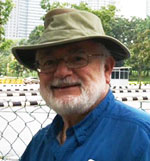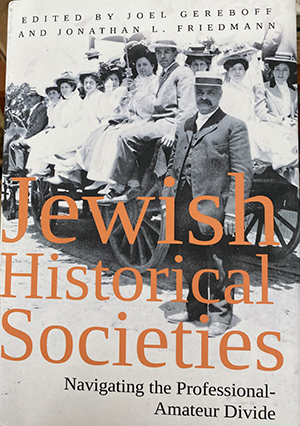Jewish Historical Societies, Navigating the Professional-Amateur Divide (Lubbock, Texas: Texas Tech University Press, 2024), Edited by Joel Gereboff and Jonathan L. Friedmann, 286 pages
By Oliver Pollak

 TETON VILLAGE, Wyoming – This is an engaging and informative study of the rise of Jewish historical societies in America. Joel Gereboff earned his Ph.D at Brown University in 1977. He is associate professor of Religious Studies at Arizona State University. Cantor Jonathan L. Friedmann, is director of the Jewish Museum of the West, president of the Western States Jewish History Association, Professor of Jewish Music History and Dean at the Academy for Jewish Religion, California. They earlier coedited Nondenominational Judaism, Perspectives on Pluralism and Inclusion in 21st-Century Jewish Professional Education in 2021.
TETON VILLAGE, Wyoming – This is an engaging and informative study of the rise of Jewish historical societies in America. Joel Gereboff earned his Ph.D at Brown University in 1977. He is associate professor of Religious Studies at Arizona State University. Cantor Jonathan L. Friedmann, is director of the Jewish Museum of the West, president of the Western States Jewish History Association, Professor of Jewish Music History and Dean at the Academy for Jewish Religion, California. They earlier coedited Nondenominational Judaism, Perspectives on Pluralism and Inclusion in 21st-Century Jewish Professional Education in 2021.
Archives have local, regional, national and international scope. The American Jewish Historical Society was founded in 1892 in New York, relocated to Brandeis University in 1968 and returned to New York in 2000. It is one of the five organizations comprising The Center for Jewish History. In the late 1980s I discussed the role of local Jewish historical societies with Bernard Wax, director of the AJHS, and Jeanne Abrams of the Rocky Mountain Jewish Historical Society. Jeanne Abrams edited Local Jewish Historical Society News. The Nebraska Jewish Historical Society, founded in 1982, hosted the AJHS annual meeting in Omaha in 1991.
The American Jewish Archives were established at Hebrew Union College in Cincinnati by Dr. Jacob Rader Marcus in 1947. National and local Jewish history societies were a mix of amateur history buffs, interested in filiopietism, triumphalism, nostalgia and the positive history of Jewish accomplishment without blemishes, and professionally trained academic historians.
Gereboff and Friedmann started this project in 2020. The eight chapters by the two editors and five contributing authors describe the movement to organize grass roots evidence in archives. Particular attention is given to the experiences in Rhode Island, Michigan, Arizona, and regional, the South, Rocky Mountains, and the Western States Jewish History Association. It is an exciting history of the alliances of American lay and scholarly commitment to their history in the wake of the Holocaust. They sought to save the past for the future. Volunteers and professionals faced similar hurdles, establishing a presence, membership, leadership, volunteers, location, visibility, funding, establishing archives, crafting exciting programs and exhibits that bridged diverse interests, education, and producing, newsletters, journals and websites.
Historical society founding documents recite their mission of procuring, collecting, and preserving records, pamphlets, letters, manuscripts, photographs, paintings, artifacts, and other items of historical interest and creating programs to encourage, stimulate, share, study, interpret, and educate. The gap between well-meaning amateur “history buffs” and professionally trained historians is methodology that identifies sources, sometimes epitomized by the use of primary and original sources, and academic reliance on critical analysis of data the iconic footnote or endnote which enhances credibility allowing readers and other scholars to verify and trace the source.
The Appendix, chronologically listing the emergence of almost 50 local and regional Jewish historical societies, tracks the momentum of the Jewish historical society movement: 8 societies appeared between 1951 and 1969 and 27 between 1971 and 1989. The pace has slowed, in the 34 years since 1990 12 societies were created. Some have changed names, some merged, not all flourished, 6 are inactive.
Spatially 16 states have statewide Jewish historical societies. There are about five regional groups. Twenty-six cities have Jewish historical societies, several prefixed with “Greater.” Connecticut has Jewish historical societies in Hartford, New Haven and Fairfield County. All it takes is for a community leader to share their desire to create a society like they saw when visiting another town.
Editor Jonathan L. Friedmann wrote the longest chapter, over a quarter of the text, on California. The Southern California Jewish Historical Society, founded in 1952, published the Western States Jewish Historical Quarterly from 1968-1983. In 1983 the Western States Jewish Historical Association broke from the SCJHS, and renamed the journal Western States Jewish History. Some readers will remember the efforts of Norton B. Stern (1920-1992) and Rabbi William Kramer (1920-2004).
I have published nine articles since 1984 in WSJHQ and WSJH and recall pleasant communications with editors Gladys Sturman and David Epstein. After 50 years of publication Western States Jewish History ceased in 2018 to appear in print. In the transition David Epstein invited San Diego Jewish World editor Donald H. Harrison to become the publisher of Western States Jewish History. Donald had published in WSJH and written at least four books on Jewish history in San Diego County. He declined, feeling he had enough on his plate, as editor of SDJW and the position should go to someone who would be able to make it a prime focus, not a sidelight. Print was resurrected with volume 51 in 2020 with Jonathan L. Friedmann as editor.
The Second World War and the Holocaust intensified intellectual, activist and sentimental interests. Jewish philanthropy supported brick and mortar bastions of memory, Holocaust memorials and museums. Endowed university chairs in Jewish, Holocaust and Genocide
Studies appeared at numerous universities. These scholars interacting with local Jewish historical societies provided professional input.
The digitized information revolution raises many questions about who owns history including access, retention, deaccessioning and destruction. Jason Lustig in A Time to Gather: Archives and the Control of Jewish Culture (2021) discusses many contemporary issues. I recently read studies employing records of the former Soviet Union and East German Stasi, a treasure trove for historians of the Cold War.
The editors of Jewish Historical Societies and Texas Tech University Press should be applauded for providing this interesting, significant and thoroughly documented volume about a major foundation for exploring American Jewish history. The digitization of historical society archival collections may exponentially increase the scale of their importance by facilitating research access well beyond the imagination of the original founders.
*
Oliver B. Pollak, Ph.D., J.D., professor emeritus of history at the University of Nebraska at Omaha, a lawyer and a member of the Institute for Historical Study, is a correspondent based in Richmond, California.
“There are as many paths to God as there are souls on this earth.” – J. Courtney Sullivan
The Jewish American Society for Historic Preservation, http://www.JASHP.org, definitely falls in the Amateur historical society definition but with major differences between objectives and results from the Professional societies.
While working on my Phd. in American Studies, I realized the problem and limitation of pure academia. Went into business instead.
JASHP does not preserve documents, building or collect and store artifacts. As a small organization, we have neither the time, funding or space for that.
Instead we focus on telling the Jewish story through historical markers and projects. To date, we have completed markers and projects in 43 States and in 8 countries. Somewhere north of 7,000,000 people annually learn a bit about the American Jewish experience and broader Jewish story. For a tiny, obscure, amateur Jewish historical society, our impact footprint is likely bigger than the biggies.
Not being sour grapes but observational. We have taken a different path along the same road.
The basic question is how to preserve and teach the story of the eternal people. There are many ways. JASHP is a way but so are the many professional Jewish historical societies who perform vital functions of academic memory.
Which way is correct, D.K.
Working together, yet differently, is the smorgasbord of Jewish preservation. Jewish education is fundamental not for Jews to just learn about Pesach or Yom Kippur. It is more than retelling at the Yom Tov table the family bubbah meisa about Aunt Tilly who sold pickles on the lower east side street corners in the driving blizzards of wintry N.Y. to pay for great Uncle Manny’s medical school education. Great Uncle Manny moved to California, got into motion pictures and became a “mogul” only to lose it all when “talkies” came about. “And that dear kids is why we are not wealthy today. Now finish you compote.”
The world of Jewish historical societies must teach the non-Jewish world about Jews. They must teach about Jewish presence, Jewish legitimacy and contributions to the magnificence of the diversity of the American melting pot.
The bottom line is both negative and positive. We all are fighting ignorance, bigotry and hate by not forgetting or permitting the past, which shapes our present and our futures, to be forgotten. For JASHP, it is even more basic – memory, commonality, fighting antisemitism..
For others, non-Jewish historical groups, remembering and preserving their own stories is to affirm the positive of the American experiment. Their telling of how each small minority struggled to come, blend, at times not smoothly, making the American story strong and stronger, can and does make the many of us into one.
DK if JASHP is included or mentioned in the book. No one contacted us. Ordered a copy of the book because it is a important historical story to be known and preserved.
B’yachad – together.